Following the announcement that the Royal Air Force is regaining nuclear weapons, we explore the service’s history using nukes, explaining why they were originally abandoned in 1998.
For 43 years, the RAF was at the forefront of the UK’s nuclear deterrent, with this mission making up a significant portion of the UK’s Cold War deterrent strategy. The RAF operated primarily in the strategic nuclear strike role from 1954 until 1968, when the Royal Navy deployed its first submarine launched ballistic missiles (SLBM).
Strategic nuclear weapons are typically high yield weapons with explosive potential several times greater than the bombs dropped at the end of the Second World War, over 100 kilotons or one megaton. They are intended to be used directly against the cities of an adversary in a counter value strike, with Moscow and Leningrad being the primary targets for the RAF in the instance of a retaliatory strike. Therein lies the main goal of a strategic nuclear weapon to deter an attack by threatening retaliation on an equal or larger scale. This concept has been traditionally named Mutually Assured Destruction (MAD).
Vulcan XH558 during a display at the RAF Leuchars Airshow celebrating the Diamond Jubilee of Her Majesty Queen Elizabeth II. (Image credit: Crown Copyright 2012/SAC Matt Baker RAF)
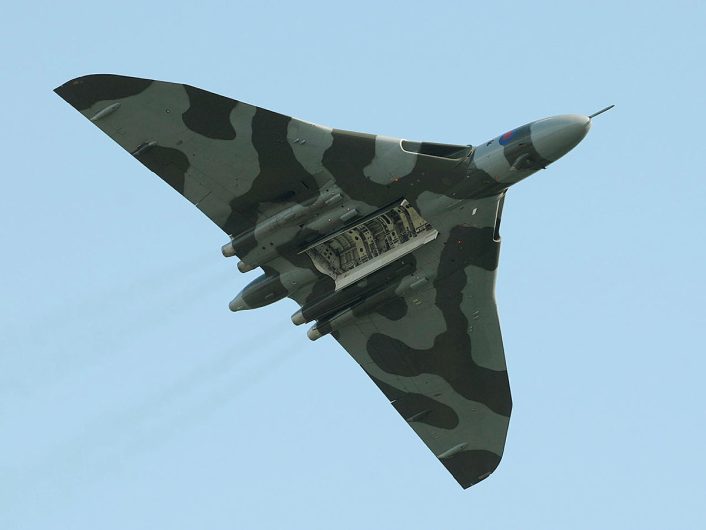
The RAF would also operate tactical nuclear weapons intended to be used on a battlefield, striking targets of military significance. These would include large military formations in the field, major military bases, concentrations of warships and even submarines. These weapons would be lower yield than strategic weapons, having the equivalent explosive potential of similar scale to the bombs used on Hiroshima and Nagasaki, around 10-20kt. They were designed to make up for the military imbalance between NATO and the Warsaw Pact, as NATO had a smaller conventional force in comparison. As a result, a number of the United Kingdom’s tactical nuclear weapons were placed under NATO command throughout the Cold War.
Strategic nuclear weapons aimed to prevent a war. Tactical nuclear weapons ensured that the RAF would win it.
But what made up these capabilities? How did this change through the course of the Cold War? And why was this role originally retired in 1998?
The UK’s Nuclear Origins
Despite contributing a significant portion of the scientists and the technology that went into the American Manhattan Project, the British government was forced out of the nuclear program when the United States implemented the McMahon Act in August 1946. Previously, the British government had been under the assumption that nuclear weapons would be shared with the US, UK and Canada who had collaborated on the original program, but the passing of the 1946 act assuaged the notion that the UK could rely on its wartime ally.
11 October 1956. A Vickers-Armstrongs Valiant B.1 (WZ366) of 49 Squadron RAF deployed Britain’s first air-dropped atomic bomb ‘Blue Danube’, over Maralinga, South Australia. pic.twitter.com/pyfAXj3DWV
— Ron Eisele (@ron_eisele) October 10, 2022
This act pushed the Labour government to begin the development of a sovereign British nuclear weapon to affirm its place as a major power in the new post war order.
Utilizing wartime research that went into the creation of the ‘Fat Man’ atomic bomb, the UK set out to build a similar fission device, that would use implosion to force two sub-critical plutonium masses together to generate the atomic explosion of the weapon. This first test device would be detonated during ‘Operation Hurricane’ on October 2, 1952 on Trimouille Island just off Western Australia, making the UK the third nation to produce a nuclear weapon.
The aftermath of a Blue Danube detonation, codenamed Buffalo R2/Marcoo. This was a ground test that took place at the Maralinga nuclear site on October 04, 1956. Blue Danube was the only live nuclear weapon dropped by the Royal Air Force. (Image credit: Australian government/Wikipedia Commons)
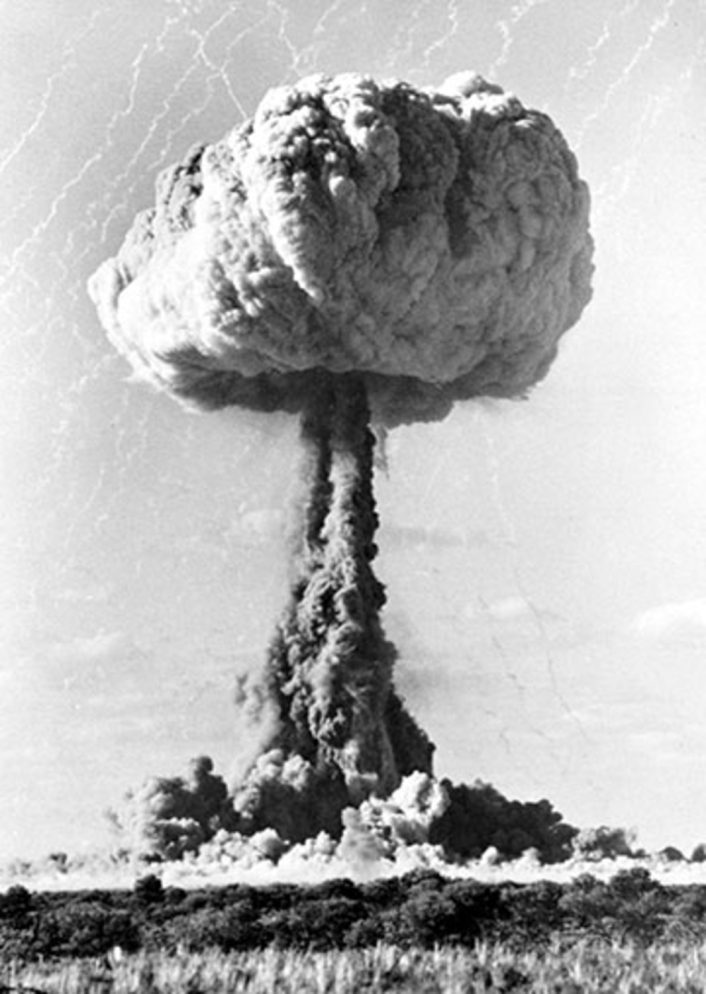

This single test and the data it generated would be used in the production of the UK’s first deployable weapon, the ‘Blue Danube’, which was built in 1953 and deployed the following year. However, ongoing development meant that the Blue Danube would be more like a nuclear test bed, as they were handmade, with varying differences between different bombs instead of being a single production design.
Handley Page Victors 1950’s. third and final V bomber to be operated by the Royal Air Force (RAF), the other two being the Vickers Valiant and the Avro Vulcan. Entering service in 1958, the Victor was initially developed as part of the United Kingdom’s airborne nuclear deterrent pic.twitter.com/CfU1rEcqI8
— Chris Bolton (@CcibChris) October 30, 2024
This meant that the weapon was unreliable for a completely reliable deterrent, so only 58 weapons were produced before production shifted to better bombs. Blue Danube had a variable yield, with 15kt being its standard, but with experimentation some versions of the weapon would be capable of 40kt explosions.
The weapon would first be detonated during ‘Operation Buffalo’ in 1956 with several tests taking place at the Maralinga Test Range in the Australian outback. This would be extremely controversial due to the program taking place on land taken from local Aborigines. Soon after, reports were seen of Aborigines returning to their lands, only to be exposed to dangerous levels of radiation, with many suffering as a result. Alongside this, lax health and safety during the tests meant that many service personnel from the British and Australian armed forces were exposed, with some suggestions that this was done deliberately to test the health effects of radiation on the human body. These incidents cast a dark shadow on the UK’s legacy of nuclear testing and are worth highlighting.
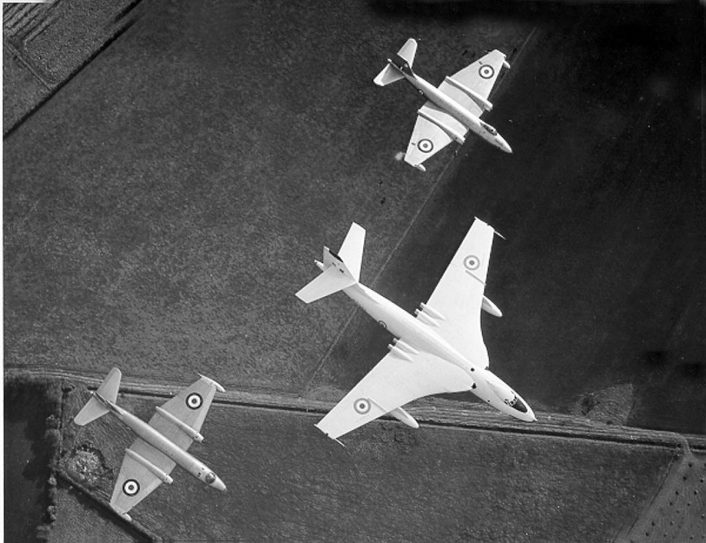

One of these nuclear tests would be a live drop with a Vickers Valiant B1 ‘WZ366’, dropping a Blue Danube from 30,000 ft on October 11th, 1956. This and several other live drops from Valiants would mark it as the only British aircraft to ever drop a live nuclear weapon. The Valiant would also drop conventional explosives during the 1956 Suez Crisis, attacking Egyptian air bases and destroying the Egyptian Air Force on the ground.
Free-fall Bomb Development
The RAF would initially employ the Blue Danube weapon for the strategic role, but its non-standard design and cumbersome arming mechanism meant it was never fit for a practical deterrent. Consequently, this led to the British government seeking a new standard weapon that could replace Blue Danube, but with a greater explosive potential.
The UK sought the ‘Super’, or H-Bomb, a thermonuclear weapon that used an initial fission reaction to kickstart the fusion of hydrogen atoms together which would produce an explosive force far greater than that of Blue Danube. ‘Operation Grapple’ would see the development of this type of weapon, with tests carried out in the Pacific islands of Malden and Kiritimati between 1957 and 1958. Here a Valiant B(K)1 ‘XD818’ would drop a test H-bomb on May 15, 1957.
The most unusual air-to-air refuelling pairing of all time? This image was actually a result of a joke between the pilot of the Sea Vixen and the crew of the Vickers Valiant. pic.twitter.com/oKenJq0OS6
— Trev Clark’s Obscure Aviation History 🚁 (@clark_aviation) August 27, 2024
‘Yellow Sun’ would be the product of these tests, providing the RAF a more reliable weapon fit for a nuclear deterrent. However, this weapon was unique, having several different nuclear warheads or ‘physics packages’, over the course of its service life with yields between 400kt and 1.1 megatons. British H-Bomb warheads were rather troublesome and so the weapon would be rather unreliable until the delivery of the Mk 2 variant which featured an American warhead. Yellow Sun would stay in service between 1959 and 1966 where it would be replaced by the WE.177.
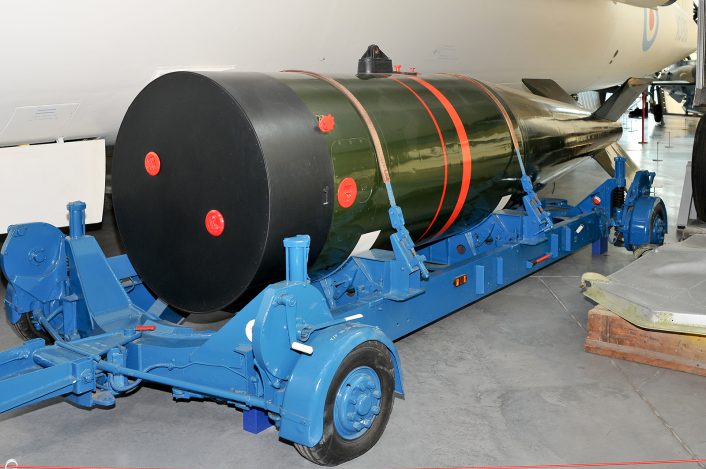

Luckily for Britain, the 1958 US–UK Mutual Defense Agreement meant that the US would share its nuclear weapons technology once again allowing the delivery of the warheads for Yellow Sun, alongside several tactical nuclear weapons. These tactical weapons, called the E-Weapons, would be used almost exclusively by English Electric Canberras operating from RAF Germany and dedicated to NATO duties. Some V-force aircraft would carry these American tactical weapons, but they would be under a dual UK-US control, where they were of limited value for an independent deterrent.
Vulcan captain John Huggins in Dr Tony Redding’s book ‘V-Bombers, Britain’s Nuclear Frontline in the Cold War’ stated that “the RAF has to rely on an American officer with a key (to the nuclear bombs). If war came, it was said that the first job of the RAF duty officer was to shoot the American and grab the key. There would be no time to lose.”
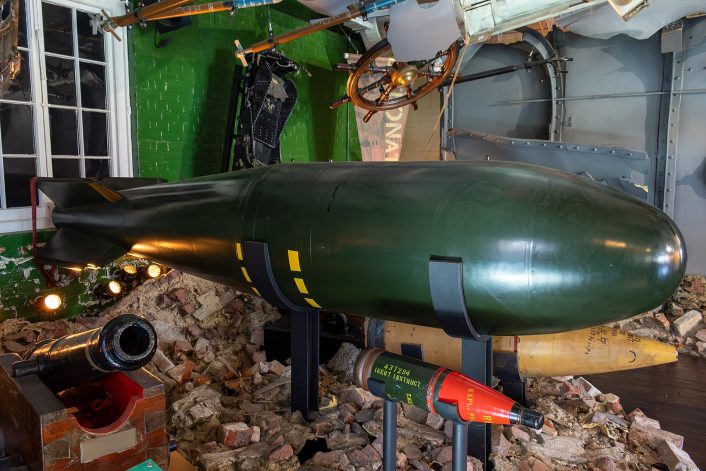

The Red Beard nuclear bomb would become the RAF’s primary tactical nuclear weapon for the early Cold War. It had a warhead similar to that of Blue Danube, but was considerably smaller and lighter allowing it to be carried by tactical aircraft, including carrier-based fighters. It came in two marks, one with a 15kt warhead and another with 25kt. Within each mark there would be two variants, one for high altitude delivery from a V-bomber or a Canberra, and the other for low altitude bombing usually deployed from a carrier borne Buccaneer.
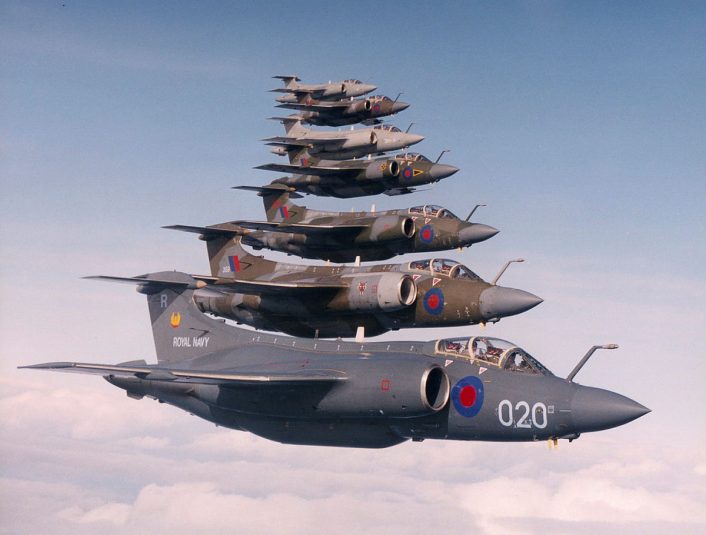

In this role the nuclear weapon would normally be toss bombed from low altitude, throwing the bomb a far distance towards a target, allowing the aircraft to avoid overflying it and risking being intercepted.
V-Force
The original size of Blue Danube dictated the size and dimensions of the aircraft that could carry it, this being a four-engine bomber that could carry a 10,000 pound bomb at 550 knots whilst flying at 55,000ft.
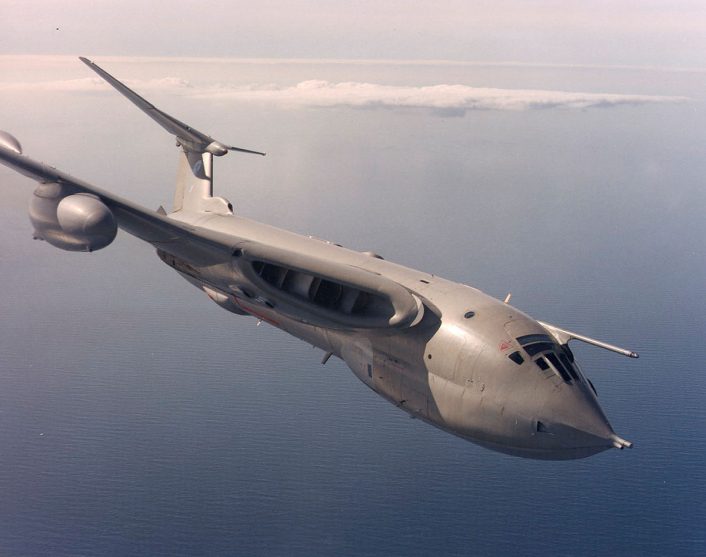

Originally four aircraft were presented to the Air Ministry for this proposal, with two advanced designs; the Handley Page Victor and the Avro Vulcan, one safe option the Vickers Valiant, and one redundancy option the Short Sperrin. As the Valiant, Vulcan and Victor all progressed well the Sperrin would be discarded and as a result the V-Force would be formed. Serving in this capacity from 1954 until late 1968, these aircraft would form the core of the UK’s nuclear deterrent, providing twenty-four hour round the clock readiness to respond to a nuclear or conventional attack from the Soviet Union.
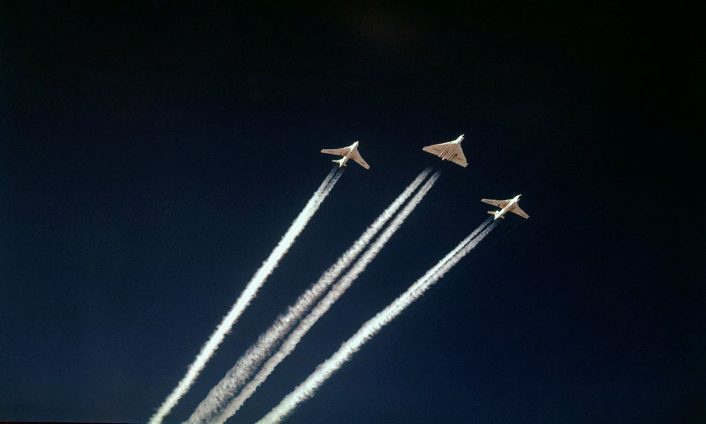

The V-Force would originally be tasked with overflying the Soviet Union to reach their targets dropping their payloads from high level, whilst avoiding enemy air defenses. However, this would change in 1960, when an American U-2 spy plane was shot down over the Soviet Union by a surface to air missile (SAM). High flying aircraft were no longer considered safe against interception and so the entire operating envelope of the V-Force had to change.
30 August 1952. First flight of the Avro Vulcan Type 698. British tailless, subsonic delta wing, high altitude strategic bomber piloted solo by Roly Falk. Operated by the Royal Air Force from 1956 until 1984. pic.twitter.com/1iUZ3gCmeF
— Ron Eisele (@ron_eisele) August 29, 2022
Instead of flying above Soviet defenses, the aircraft would have to fly low, below the radar horizon delaying the time it would take for the Soviet Union to spot the nuclear bombers and respond. As a result, these aircraft would receive a new camouflage scheme going forwards, from all white anti-flash to a white underbelly and a grey/green wrap on the top of the airframe.
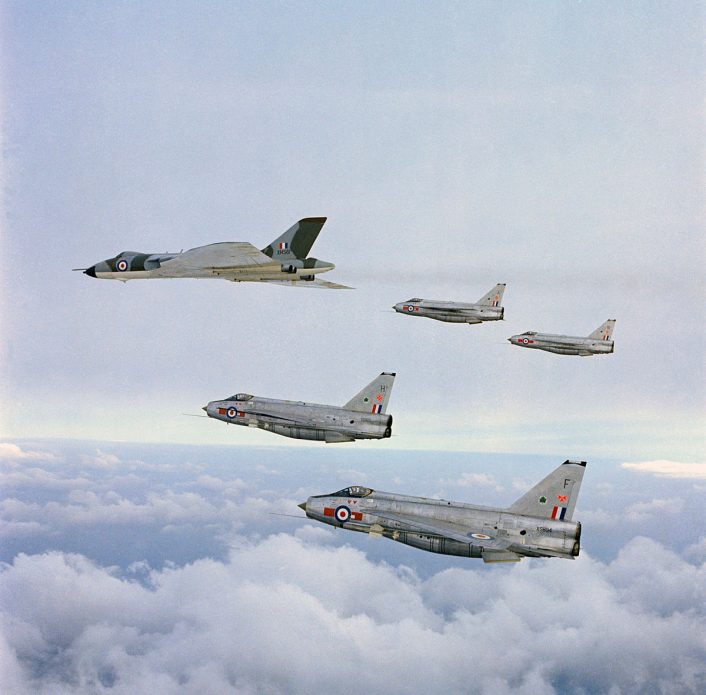

The Victor and the Vulcan would perform well in the low level flight envelope, but the Valiant would soon be discovered to be developing cracks in the wings from low level turbulence. This meant that the Valiant would be retired from service in January 1965 leaving the Vulcan and the Victor to soldier on until the early 1980s.
Stand-off Nuclear Weapons
Work had already been done to give the RAF standoff nuclear weapons prior to the U-2 shoot down, in order to ensure that the aircraft could deliver a nuclear payload without overflying targets and getting shot down. The initial result was the ‘Blue Steel’ air launched Nuclear rocket, which had a range of 100 nautical miles carrying a warhead similar to that used by Yellow Sun. However, the missile’s range would be significantly lower when operating from low level, making it an interim missile until a suitable and practical replacement could be sourced.
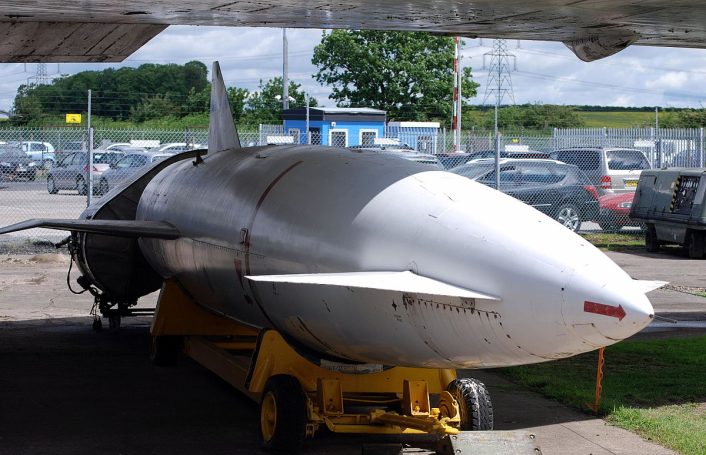

The Vulcan was selected to field the replacement for Blue Steel, with this being the US designed ‘Skybolt’ Air Launched Ballistic Missile (ALBM). The Vulcan would be able to carry a missile under each wing, meaning that 72 Vulcans could carry 144 weapons, lowering the number of aircraft required for a full nuclear deterrent. However, in 1962 the US cancelled the program owing to the cheaper and already in service alternative of a submarine launched ballistic missile (SLBM), Polaris.
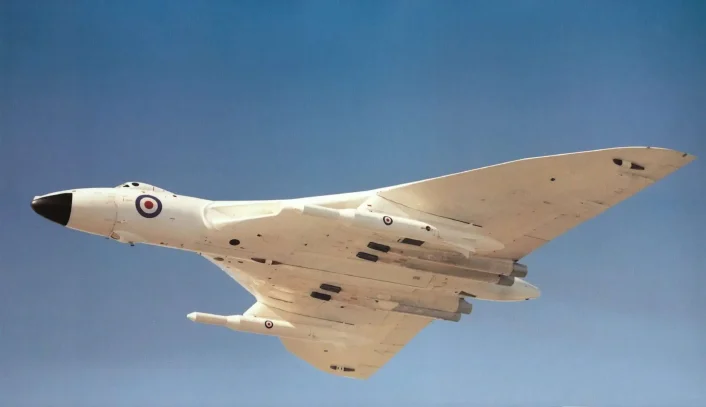

Crucially, this was a difficult position for the UK to be in, given that it had staked the entire future of its nuclear deterrent upon the Skybolt missile system, with the British equivalents having been cancelled years prior. Due to this, British Prime Minister Harold Macmillan would meet with US President John F. Kennedy in December 1962 to work out a deal for the UK to instead receive the Polaris SLBM. Whilst the warheads would be British, the missiles would be American allowing the UK to continue to field a sovereign deterrent with only the Prime Minister’s approval being needed to launch, unlike previous American tactical weapons.
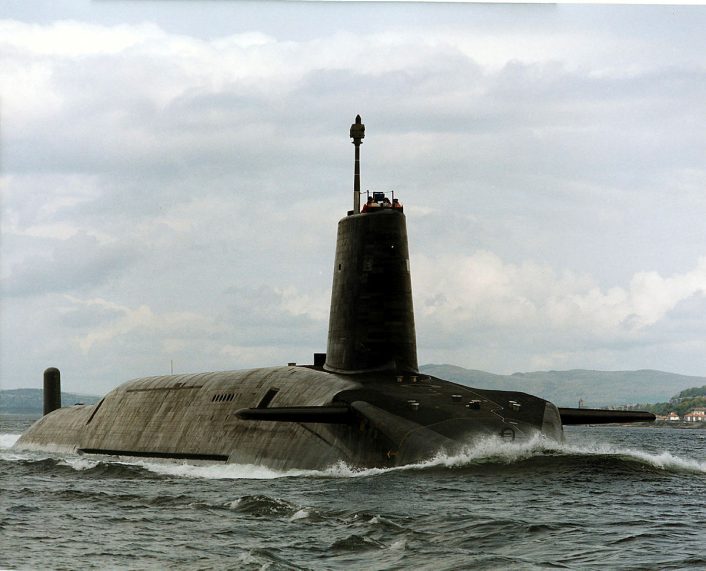

This decision to take on SLBMs took the strategic nuclear deterrent role away from the RAF and placed it right into the hands of the Royal Navy, where it continues on today.
WE.177
The last British airborne nuclear weapon to be developed was the WE.177, which was a significant improvement over all other British nuclear weapons up until that point. It was smaller and less bulky than its predecessors, but most importantly it could be armed in flight. This meant that ground crews no longer had to take extra time on the ground readying the weapon when time was of the essence to get an aircraft into the air and on its way to Moscow. This was the pinnacle of the RAF’s nuclear development allowing for far quicker responses to a possible Soviet strike on the UK or NATO.
The Avro vulcan is a jet powered, tailless, delta wing, high altitude strategic bomber. Sound Up 🔊
📹 raf_aviation@ron_eisele @marklanebiz @AviateAddict #RIN #Navigation #aviation #avgeek pic.twitter.com/sVZG8UcrNV
— Royal Institute of Navigation (@at_RIN) August 10, 2018
Produced in three variants it was deployed in both the tactical and strategic role replacing all the other air dropped nuclear weapons in RAF service. From 1966 it had been intended to be carried by the fabled TSR.2 strike aircraft, but the aircraft was cancelled in the 1966 Defence Review. Consequently, WE.177 would be deployed from what was left of the V-Force, the Vulcan and the Victor until they could themselves be replaced by Jaguar and Tornado fighter bombers coming online during the 1970s.
Most pressing was the need to replace Yellow Sun, as its deployment envelope required a minimum height of 11,000ft to be dropped which was not possible for aircraft flying low level around 100ft. This spawned the WE.177B which could be dropped from as low as 50 ft off the ground. The weapon had a yield of 450kts and was used by the V-Force initially in the strategic role, until Polaris was introduced in 1968.
From that point on the V-Force would become a sub-strategic force focusing on periphery targets that were not as important to the Soviet Union as Moscow. Both Blue Steel armed Vulcans and Victors and WE.177-armed Vulcans would operate this way until Blue Steel was retired in 1970, leaving only the Vulcan left in service as a nuclear bomber. The Victor would go on to see new life as a tanker, retiring from service in 1993. The Vulcan would soon follow in 1983, but not before seeing use in the conventional bombing role during the Falklands War for ‘Operation Black Buck’.
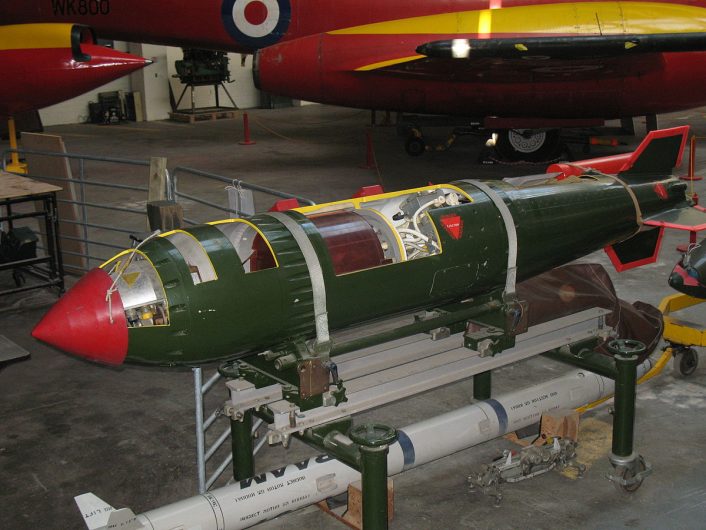

WE.177A was a tactical variant, designed primarily to replace the Red Beard in both the RAF and the Royal Navy. It was the lightest of the UK’s nuclear weapons and was even carried by helicopters in the anti-submarine warfare role. The Navy would use the WE.177A as a depth charge, allowing helicopters to attack Soviet submarines without the need for precision weapons. It would enter service after WE.177B and would have a 10kt yield.
A number of these weapons were present on ships of the Royal Navy’s task force sent to liberate the Falkland Islands in 1982, with these weapons being carried on board frigates and destroyers. These weapons would be stored on the two carriers HMS Hermes and HMS Invincible, before they were sailed off prior to the start of combat operations.
WE.177C would be the final variant of the weapon, being produced with a 190kt warhead and used in the tactical nuclear strike role at RAF Germany for the UK’s contribution to NATO’s tactical nuclear strike mission. This was primarily used during the later stages of the Cold War by RAF Tornado and Jaguar strike aircraft long after the V-Force had retired from service. Royal Navy Sea Harriers and Royal Navy/RAF Buccaneers also used the WE.177C in the anti-shipping role up until their retirements in the mid 1990s.
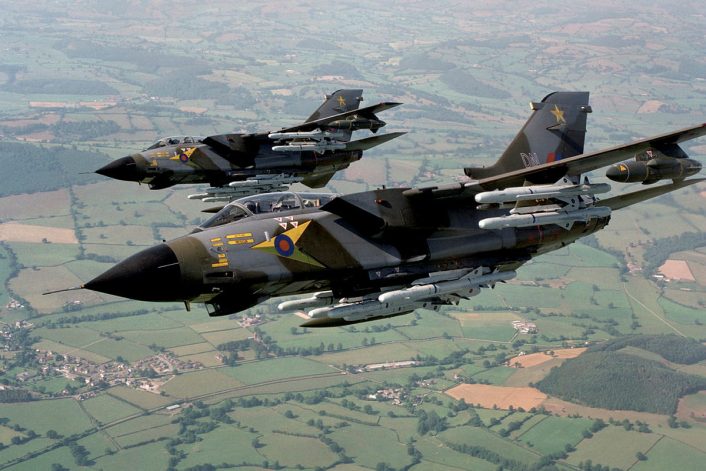

The End of Tactical Nuclear Strike
By 1990 the RAF had 72 UK-based strike bombers carrying WE.177, two squadrons each of Tornado, Jaguar and Buccaneer. In Germany, 84 Tornado aircraft were distributed amongst seven squadrons with all capable of nuclear strike. But this requirement was soon to disappear. The Cold War would end in 1991 with the Warsaw Pact and Soviet Union dissolving themselves almost overnight, leaving the RAF without a target for its nuclear weapons.


Without the threat of the Soviet Union the British government saw fit to retire a significant portion of their tactical nuclear weapon stockpiles, owing to the lack of an enemy they would be needed against. The RAF initially saw its WE.177 stockpile reduced to 50% with the disbandment of a number of operational nuclear squadrons around the mid 1990s. RAF Germany would very quickly close, with its aircraft returning to the UK to be retired or amalgamated with other operational squadrons. The final RAF Tornado would leave Germany in 2001, closing the command for good.
The programs running to replace the WE.177 were eventually also cancelled owing to the lack of threat from the now dissolved Soviet Union leaving the WE.177 as the last nuclear weapon in RAF service. It would itself be retired in 1998, leaving RAF Marham for the last time and shutting the door on RAF nuclear operations, for good.
Until now.
The RAF is excited to announce the procurement of 12 new F-35A jets.⚡💪
These fifth-gen aircraft can fly in @NATO nuclear crisis missions, strengthening our nuclear deterrence, & ensuring we are ready to fly, fight and win against threats.
Read more: pic.twitter.com/NT6MOo8ogg
— Royal Air Force (@RoyalAirForce) June 25, 2025
The Peace Dividend that had been in effect following the collapse of the Soviet Union is now dead.
Old enemies have returned and the world is now more unstable than it had been at any point since the Cold War. Some have even labelled this new period as the Second Cold War. The UK and the RAF must be prepared for any contingency, and a return to tactical nuclear weapons may now be the way to do it.
Only time will tell…
Source link
[aviation news]
Share this content:


